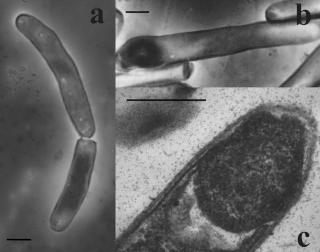Related Research Articles
Thermoanaerobacter is a genus in the phylum Bacillota (Bacteria). Members of this genus are thermophilic and anaerobic, several of them were previously described as Clostridium species and members of the now obsolete genera Acetogenium and Thermobacteroides
Deferribacter is a genus in the phylum Deferribacterota (Bacteria).
Pelotomaculum is a Gram-positive strictly anaerobic, mesophilic, thermophilic and non-motile bacterial genus from the family of Peptococcaceae.

Carboxydocella is a Gram-positive and obligate anaerobe bacterial genus from the family of Syntrophomonadaceae.
Melghirimyces is a bacterial genus from the family of Thermoactinomycetaceae.
Planifilum is a Gram-positive and aerobic bacterial genus from the family of Thermoactinomycetaceae.
Desulfotignum is a Gram-negative and strictly anaerobic bacteria with a single polar flagellum genus from the family of Desulfobacteraceae.
Caldanaerobius is a genus of thermophilic, obligately anaerobic bacteria from the family of Thermoanaerobacteraceae.
Carboxydothermus is a genus of thermophilic, anaerobic bacteria from the family of Thermoanaerobacteraceae.
Sphaerisporangium is a Gram-positive genus of bacteria from the family of Streptosporangiaceae.
Solirubrobacter is a Gram-positive, spore-forming, aerobic, mesophilic and non-motile genus of bacteria from the family Solirubrobacteraceae.
Garciella is a Gram-positive, halotolerant, obligately anaerobic and moderately thermophilic bacterial genus from the family of Eubacteriaceae with one known species.
Hippea is an obligate anaerobic and moderately thermophilic bacteria genus from the family of Desulfobacteraceae. Hippea is named after the German microbiologist Hans Hippe.
Mahella is a genus in the phylum Bacillota (Bacteria). The name Mahella derives from: Neo-Latin feminine gender dim. noun Mahella, named in honour of the American microbiologist Professor R.A. Mah, for his important contribution to the taxonomy of anaerobes.
Caldicoprobacter is a genus of bacteria from the family of Caldicoprobacteraceae.
Caldicoprobacter guelmensis is a Gram-positive, thermophilic, non-spore-forming, anaerobic, xylanolytic and non-motile bacterium from the genus of Caldicoprobacter which has been isolated from water from a hot spring from Guelma in Algeria.
Anaerolineaceae is a family of bacteria from the order of Anaerolineales. Anaerolineaceae bacteria occur in marine sediments. There are a total of twelve genera in this family, most of which only encompass one species. All known members of the family are Gram-negative and non-motile. They also do not form bacterial spores and are either mesophilic or thermophilic obligate anaerobes. It is also known that all species in this family are chemoheterotrophs.
Caldilinea is a genus of bacteria from the family of Caldilineaceae.
Coprothermobacterota is a phylum of nonmotile, rod-shaped bacteria.
Paramaledivibacter caminithermalis is a species of bacteria in the family Peptostreptococcaceae. Clostridium caminithermale has been reclassified to Paramaledivibacter caminithermalis. Paramaledivibacter caminithermalis has been isolated from a deep-sea hydrothermal vent from the Atlantic Ocean Ridge.
References
- 1 2 J.P. Euzéby. "Caldanaerobacter". List of Prokaryotic names with Standing in Nomenclature (LPSN). Retrieved 2022-09-09.
- ↑ "Caldanaerobacter hydrothermalis". www.uniprot.org.
- ↑ "Caldanaerobacter proteolyticus". www.uniprot.org.
- 1 2 "Caldanaerobacter". www.uniprot.org.
- ↑ Parker, Charles Thomas; Osier, Nicole Danielle; Garrity, George M; Taylor, Dorothea (2009). Parker, Charles Thomas; Garrity, George M. (eds.). "Nomenclature Abstract for Caldanaerobacter". The NamesforLife Abstracts. doi:10.1601/nm.4521 (inactive 2024-04-17).
{{cite journal}}: CS1 maint: DOI inactive as of April 2024 (link) - ↑ Fardeau, Marie-Laure; Ollivier, Bernard; Cayol, Jean-luc (2015). "Caldanaerobacter". Bergey's Manual of Systematics of Archaea and Bacteria. John Wiley & Sons, Ltd: 1–5. doi:10.1002/9781118960608.gbm00745. ISBN 9781118960608.
- ↑ Sayers; et al. "Caldanaerobacter". National Center for Biotechnology Information (NCBI) taxonomy database. Retrieved 2022-09-09.
- ↑ "The LTP" . Retrieved 23 February 2022.
- ↑ "LTP_all tree in newick format". Archived from the original on 4 September 2022. Retrieved 23 February 2022.
- ↑ "LTP_01_2022 Release Notes" (PDF). Retrieved 23 February 2022.